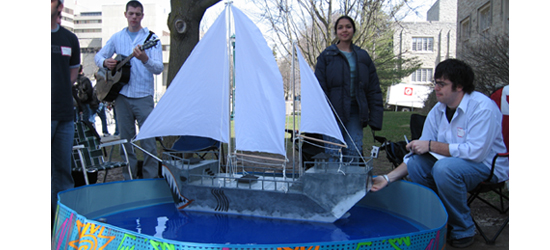Engineering Now .: Volume 2 - Edition 10 .: April 21, 2006
First-year students display solutions to real-world problems

First-year Western Engineering students displayed their prototype solutions addressing real-world issues facing developing nations as part of the ES050-Engineering Design and Innovation Studio on Monday, April 10 in Great Hall.
The projects were led by engineering professors from different disciplines including: Dr. Rohani and Dr. Ray (CBE); Dr. Hinchberger and Dr. Southen (CEE); Dr. Sabarinathan and Dr. Samani (ECE); and Dr. Sun and Dr. Kurowski (MME). Students worked in teams of 6 in eight different Design Studios.
Student projects included prototypes such as:
Doug Farough, a first-year engineering student and member of the East Indian Fishing Boat team, found the project rewarding for two reasons. “The project gave me the opportunity to design a prototype and learn to work in a team, but it also opened my eyes to the devastation that exists in third-world countries,” he explains. “I knew there was a Tsunami, but I didn’t realize how severe the destruction was until I researched for this project.”
The objectives of the design projects were to provide an awareness of global issues and also to learn the design process through open ended problems.
One team of students studied the collection of Hippo Grass in Malawi. During their research they found Malawi’s rivers were infested with Hippo Grass, causing blockages in damns and waterways. The student group explained Malawi currently spends unnecessary money and resources to operate a crane to collect and dispose the grass. The students found this removal process was inefficient for two reasons: (1) Using a crane to remove the Hippo Grass is costly, and (2) when the crane removes the grass, the grass can not be reused for other resources. The students’ suggest a pulley-system be constructed in place of a crane to safely remove the grass from the damns.
“Hippo Grass is a great source of fiber,” explained one team member. “If removed safely, the grass can be reused as a food source for humans, cattle and livestock. Eliminating the crane will allow the grass to be removed for future use, and reduce on the cost.”
ES050 is a first-year engineering course, introducing students to principles and practices of professional engineering design. A design studio approach is used to encourage innovative thinking and problem-solving skills within a structured context.
Also from this web page:
Contact
.: Allison Stevenson
Spencer Engineering Building, Room 2074
Telephone: (519) 850-2917 Fax: (519) 661-3808
contactweATeng.uwo.ca


